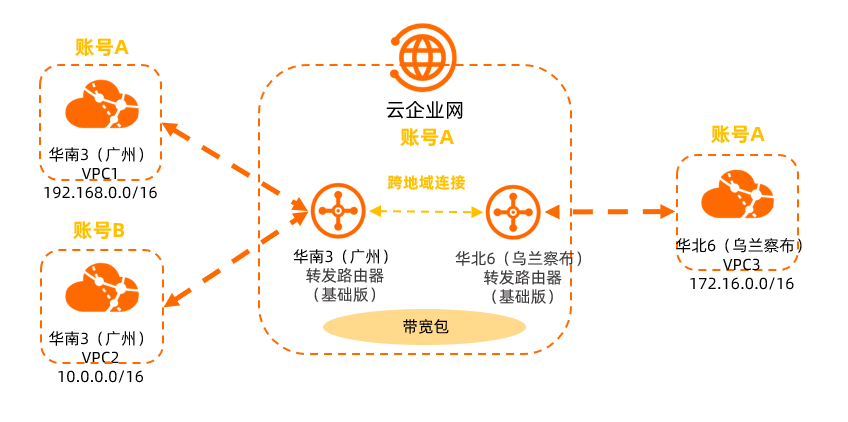本文指導您如何使用雲企業網及基礎版轉寄路由器實現跨地區跨帳號Virtual Private Cloud(Virtual Private Cloud)互連。
基礎版轉寄路由器支援的地區
情境樣本
自2022年03月31日起,僅雲串連網地區支援基礎版轉寄路由器,其他地區已停止售賣基礎版轉寄路由器,這些地區預設僅支援企業版轉寄路由器。推薦您將這些地區的基礎版轉寄路由器升級為企業版轉寄路由器,體驗更豐富的功能特性以及更大規模的企業級組網能力。具體操作,請參見升級基礎版轉寄路由器。
本情境中預設A帳號下已擁有雲企業網執行個體,且雲企業網執行個體下華南3(廣州)地區和華北6(烏蘭察布)地區已擁有基礎版轉寄路由器執行個體。如果您的帳號下並沒有基礎版轉寄路由器執行個體,請使用企業版轉寄路由器實現本情境。具體操作,請參見使用雲企業網實現跨地區跨帳號VPC互連(企業版)。
某企業使用帳號A在阿里雲華南3(廣州)地區、華北6(烏蘭察布)地區分別建立了VPC1和VPC3,使用帳號B在華南3(廣州)地區建立了VPC2,3個VPC使用Elastic Compute Service(Elastic Compute Service)分別部署了相關服務,各個VPC之間互不相通。現在因業務發展需要,企業需要3個VPC可以相互連信,資源互訪。
企業可以使用雲企業網產品,將華南3(廣州)地區的VPC1和VPC2串連至帳號A下華南3(廣州)地區的轉寄路由器執行個體(基礎版),將華北6(烏蘭察布)地區的VPC3串連至帳號A下華北6(烏蘭察布)地區的轉寄路由器執行個體(基礎版),然後通過頻寬包和跨地區串連實現帳號A下華南3(廣州)地區和華北6(烏蘭察布)地區的網路互連,進而實現3個VPC相互連信。

前提條件
您已經使用帳號A在華南3(廣州)地區、華北6(烏蘭察布)地區各建立了1個VPC,使用帳號B在華南3(廣州)地區建立了1個VPC,3個VPC均使用ECS部署了相關服務。具體操作,請參見搭建IPv4專用網路。
本樣本3個VPC網路規劃如下表所示,在您規劃網路時請確保要互連的網段沒有重疊。
屬性
VPC1
VPC2
VPC3
網路執行個體的網段規劃
VPC網段:192.168.0.0/16
交換器網段:192.168.0.0/24
VPC網段:10.0.0.0/16
交換器網段:10.0.0.0/24
VPC網段:172.16.0.0/16
交換器網段:172.16.0.0/24
網路執行個體所屬地區
華南3(廣州)
華南3(廣州)
華北6(烏蘭察布)
網路執行個體所屬帳號
帳號A
帳號B
帳號A
ECS執行個體IP地址
192.168.0.239
10.0.0.121
172.16.0.201
您已經瞭解3個VPC中ECS執行個體所應用的安全性群組規則,並確保安全性群組規則允許3個VPC資源互訪。具體操作,請參見查詢安全性群組規則和添加安全性群組規則。
步驟一:跨帳號VPC執行個體授權
在將帳號B的VPC2串連至帳號A之前,需要在帳號B中操作授權,允許帳號A下的轉寄路由器執行個體串連VPC2。
使用帳號B登入專用網路管理主控台。
在頂部功能表列,選擇VPC2所屬的地區。本樣本選擇華南3(廣州)。
在專用網路頁面,找到VPC2,單擊VPC2執行個體ID。
單擊跨帳號授權頁簽。在雲企業網頁簽下,單擊雲企業網跨帳號授權。
在加入雲企業網對話方塊,根據以下資訊進行配置,然後單擊確定。
配置項
說明
對方帳號UID
轉寄路由器執行個體所屬的阿里雲帳號(主帳號)ID。
本樣本為帳號A的帳號ID。
對方雲企業網執行個體ID
轉寄路由器執行個體所屬的雲企業網執行個體ID。
本樣本為帳號A下的雲企業網執行個體ID。
資費承擔方式
選擇付費方。
CEN使用者承擔資費(預設值):表示VPC執行個體產生的串連費和流量處理費由轉寄路由器執行個體所屬的帳號承擔。
VPC使用者承擔資費:表示VPC執行個體產生的串連費和流量處理費由VPC執行個體所屬的帳號承擔。
本樣本使用預設值。
說明使用基礎版轉寄路由器執行個體串連VPC執行個體時,不會產生串連費和流量處理費,本參數不生效。
步驟二:串連VPC執行個體
VPC2為帳號A授權後,您需要將VPC1、VPC2、VPC3串連至帳號A的轉寄路由器執行個體,在帳號A中實現網路互連。
使用帳號A登入雲企業網管理主控台。
在雲企業網執行個體頁面,單擊目標雲企業網執行個體ID。
在頁簽,找到任意地區的轉寄路由器執行個體,在操作列單擊创建网络实例连接。
在串連網路執行個體頁面,根據以下資訊進行配置,然後單擊確定建立。
執行個體類型:選擇待串連的網路執行個體類型。
地區:選擇待串連的網路執行個體所在的地區。
轉寄路由器:系統自動顯示該地區下已建立轉寄路由器執行個體。
資源歸屬UID:選擇待串連的網路執行個體所屬的帳號類型。
網路執行個體:選擇待串連的網路執行個體。
依據上述資訊,分別將VPC1、VPC2、VPC3串連至帳號A中,串連VPC1、VPC2、VPC3時各個配置項的值如下表所示。
配置項
VPC1
VPC2
VPC3
執行個體類型
Virtual Private Cloud
Virtual Private Cloud
Virtual Private Cloud
地區
華南3(廣州)
華南3(廣州)
華北6(烏蘭察布)
資源歸屬UID
同帳號
跨帳號
選擇跨帳號後,需輸入帳號B的阿里雲帳號(主帳號)ID。
同帳號
網路執行個體
選擇VPC1
選擇VPC2
選擇VPC3
完成上述操作後,VPC1、VPC2、VPC3已自動學習到對方的路由條目。VPC1與VPC2之間可以正常通訊,VPC3與VPC1之間、VPC3與VPC2之間為跨地區網路,雲企業網預設提供1 Kbps的跨地區互連頻寬(IPv4),僅供測試跨地區網路的連通性,跨地區的網路資源無法正常通訊。例如您可以在每個VPC內建立ECS,然後在ECS中使用
ping命令驗證連通性。
步驟三:購買頻寬包
為實現VPC3與VPC1、VPC3與VPC2的資源正常通訊,需要購買頻寬包並建立跨地區串連。
使用帳號A登入雲企業網管理主控台。
在雲企業網執行個體頁面,單擊目標雲企業網執行個體ID。
在雲企業網執行個體詳情頁面,選擇,單擊購買頻寬包(預付費)。
根據以下資訊配置頻寬包,然後單擊立即購買並完成支付。
配置項
說明
雲企業網
選擇需購買頻寬包的雲企業網執行個體。
完成支付後,頻寬包自動綁定至該雲企業網執行個體。
本樣本選擇帳號A下的雲企業網執行個體。
地區-A
選擇參與互連的網路執行個體所在地區。
本樣本選擇中國內地。
說明頻寬包建立後,不支援修改互連地區。
頻寬包支援的地區及地區資訊,請參見使用頻寬包。
地區-B
選擇參與互連的網路執行個體所在地區。
本樣本選擇中國內地。
計費方式
顯示頻寬包的計費方式。預設為按頻寬計費。
計費資訊,請參見計費說明。
頻寬值
請根據實際業務需求選擇頻寬包的頻寬值。單位:Mbps。
頻寬包名稱
輸入頻寬包的名稱。
購買時間長度
選擇頻寬包的購買時間長度。
選中到期自動續約可開啟頻寬包自動續約功能。
步驟四:建立跨地區串連
使用帳號A登入雲企業網管理主控台。
在雲企業網執行個體頁面,單擊目標雲企業網執行個體ID。
在頁簽,單擊設定跨地區頻寬。
在串連網路執行個體頁面,配置跨地區串連資訊,然後單擊確定建立。
配置項
說明
執行個體類型
選擇跨地區。
地區
要互連的地區。
本樣本選擇華南3(廣州)。
轉寄路由器
系統自動顯示當前地區下的轉寄路由器執行個體ID。
對端地區
要互連的對端地區。
本樣本選擇華北6(烏蘭察布)。
轉寄路由器
系統自動顯示當前地區下的轉寄路由器執行個體ID。
标签
為跨地區串連添加標籤。
本樣本保持為空白值。
頻寬包執行個體
選擇雲企業網執行個體已綁定的頻寬包執行個體。
頻寬
輸入跨地區串連的頻寬值。單位:Mbps。
步驟五:測試連通性
完成上述操作後,VPC1、VPC2、VPC3之間可以正常通訊。以下內容為您展示如何測試3個VPC之間的連通性。
本樣本中VPC1、VPC2、VPC3的ECS執行個體安裝了Alibaba Cloud Linux作業系統,如果您使用的是其他動作系統,關於如何使用ping命令請參見您的作業系統手冊。
測試VPC1和VPC2之間的連通性。
登入VPC1的ECS執行個體。具體操作,請參見ECS遠端連線操作指南。
在VPC1的ECS執行個體中執行ping命令,嘗試訪問VPC2的ECS執行個體。
ping <VPC2 ECS執行個體IP地址>收到如下所示的回複報文,則表示VPC1和VPC2之間網路已連通,VPC1與VPC2的資源可以正常通訊。

測試VPC3與VPC1之間的連通性。
登入VPC3的ECS執行個體。
在VPC3的ECS執行個體中執行ping命令,嘗試訪問VPC1的ECS執行個體。
#通過指定ping命令的報文長度為2000位元組,測試VPC3與VPC1的連通性,以確保VPC3與VPC1的資源可以跨地區互連。 ping <VPC1 ECS執行個體IP地址> -s 2000收到如下所示的回複報文,則表示VPC3和VPC1之間網路已連通,VPC3與VPC1的資源可以正常通訊。

測試VPC3與VPC2之間的連通性。
登入VPC3的ECS執行個體。
在VPC3的ECS執行個體中執行ping命令,嘗試訪問VPC2的ECS執行個體。
#通過指定ping命令的報文長度為2000位元組,測試VPC3與VPC2的連通性,以確保VPC3與VPC2的資源可以跨地區互連。 ping <VPC2 ECS執行個體IP地址> -s 2000收到如下所示的回複報文,則表示VPC3和VPC2之間網路已連通,VPC3與VPC2的資源可以正常通訊。
